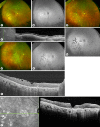Insights from a Case of Vitreoretinal Lymphoma
- PMID: 30675472
- PMCID: PMC6341330
- DOI: 10.1159/000487949
Insights from a Case of Vitreoretinal Lymphoma
Abstract
Purpose/background: The aim of this study was to report a patient with vitreoretinal lymphoma with clinical features providing hypothesis-generating insights into the pathophysiology of this disease.
Methods: Clinical history and imaging studies (i.e., fundus photography, optical coherence tomography, fundus autofluorescence, and fluorescein angiography) were documented.
Results: A 71-year-old woman presented with a 2-month history of blurred vision in the right eye and bilateral vitreous infiltrates unresponsive to topical and systemic steroids. Vitreous biopsy of the left eye was diagnostic for lymphoma. Bulky subretinal deposits in the right eye responded to systemic therapy. The left fundus showed diffuse hypoautofluorescence and punctate, hyperfluorescent sub-retinal pigment epithelial tumor deposits, which resolved leaving hypoautofluorescent atrophic retinal pigment epithelium (RPE) scars, except inferotemporally, where retinal vasculopathy had occurred.
Conclusions: The clinical features suggest that occlusion of the inferotemporal retinal arteriole prevented sub-RPE lymphomatous deposits and subsequent RPE atrophy in this area of vascular nonperfusion. This suggests that "primary" vitreoretinal lymphoma is secondary to hematogenous spread from systemic loci. This finding, together with the ocular tumor control achieved entirely by systemic therapy, indicates scope for studies investigating systemic treatment protocols, especially those including immune-modulatory agents.
Keywords: Lymphoma; Retinal disease.
Figures




References
-
- Araujo I, Coupland SE. Primary vitreoretinal lymphoma - a review. Asia Pac J Ophthalmol. 2017;6:283–289. - PubMed
-
- Reichstein D. Primary vitreoretinal lymphoma: an update on pathogenesis, diagnosis and treatment. Curr Opin Ophthalmol. 2016;27:177–184. - PubMed
-
- Witmer MT. Primary vitreoretinal lymphoma: management of isolated ocular disease. Cancer Control. 2016;23:110–116. - PubMed
-
- Teckie S, Yahalom J. Primary intraocular lymphoma: treatment outcomes with ocular radiation therapy alone. Leuk Lymphoma. 2014;55:795–801. - PubMed
-
- Frenkel S, Hendler K, Siegal T, Shalom E, Pe'er J. Intravitreal methotrexate for treating vitreoretinal lymphoma: 10 years of experience. Br J Ophthalmol. 2008;92:383–388. - PubMed

